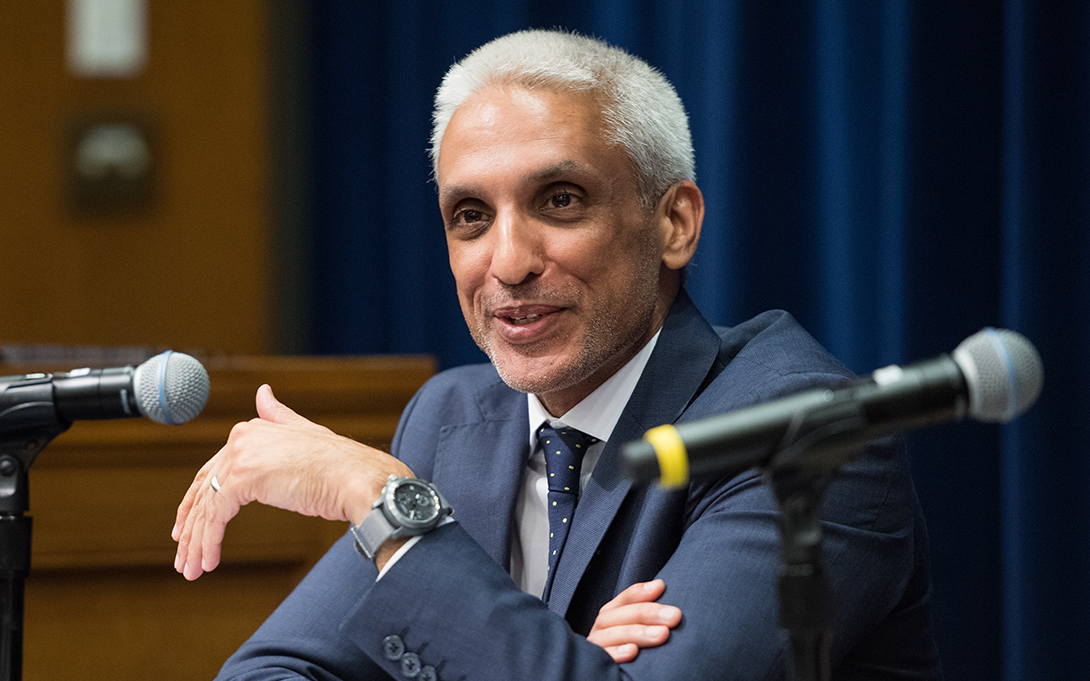
As the Biden administration embarks on its first hundred days, experts from the Gerald R. Ford School of Public Policy have produced a series of policy briefs on key issues. Download the PDF of this brief or read the web-formatted version below.
By Javed Ali, Towsley Policymaker in Residence
Overview
Even before the events at the U.S. Capitol on January 6, mounting evidence of FBI investigations, arrests, and successful attacks indicated intensifying domestic terrorism threats—the far-right aspect of this being the most lethal. There were several factors that contributed to the siege on the Capitol in just the last year alone: the impact of COVID-19 and government-imposed restrictions that affected individual liberties and freedoms; the deepening political, cultural and social polarization that started with President Trump’s first impeachment trial in January last year through the November 2020 elections, and now into 2021; the significant amount of fake news and misinformation peddled not only by conspiracy theorists and QAnon supporters, but mainstream media and elected officials; and, the role of social media platforms acting as the virtual ecosystems where extremist ideas and beliefs could be widely shared and disseminated.
A new threat at home
The current framework of laws, policies, authorities, and capabilities to confront domestic terrorism has not kept pace with evolving landscape. For years after 9/11 the U.S. counterterrorism enterprise was focused on international terrorism threats against the United States homeland, mostly from groups like al-Qa’ida and ISIS in the “global jihadist” camp. What we are experiencing now is qualitatively, if not quantitatively different, since the individuals who present the most serious threats of politically-or ideologically motivated violence:
- Are Americans born and raised here who enjoy the full protections of the Constitution and other laws;
- Do not operating under the banner of one cohesive or monolithic group; and,
- Subscribe to a range of different ideas and beliefs—sometimes in combination—to justify violent action.
One of the unique features about the far-right extremist phenomenon in the United States is that it is ideologically diffuse and fragmented, in addition to lacking any unified organizational group-based structure. A significant number of individuals in the far-right extremist space believe in white supremacist, neo-Nazi, and other “hate”-based beliefs against those with different political, racial, religious, or gender backgrounds. Others have more strident anti-government, anti-law enforcement, and pro-2nd amendment views, while there are also ideological strands that incorporate millenarian and apocalyptic views—in addition to conspiracy theories like QAnon that defy logic. Some individuals can move between these belief systems during the process of radicalization to mobilization to violence. As a result, ascribing this threat with one single ideological or organizational label is difficult, which makes it unconventional from traditional counterterrorism analysis which has rested on group-based taxonomies.
Policy solutions
As the Biden administration pursues a new approach to tackle this challenge, their action plan will need to be comprehensive, but also flexible and mindful of the legal and civil liberties/civil rights concerns that critics will raise across the political spectrum.
- Intelligence analysis: Strengthen the already-planned intelligence assessment by the Office of the Director of National Intelligence by combining and coordinating FBI and DHS insights, and including analysis of the full extent of white supremacist and hate-related beliefs within the far-right extremist landscape. A more holistic domestic terrorism intelligence picture could then be combined with perspectives on the foreign intelligence side to examine potential linkages with extremist groups or networks overseas to help further understand activity here.
- Legal frameworks: Closely examine whether a new legal framework that attaches criminal penalties to domestic terrorism, and/or a domestic terrorism organization list, are necessary to significantly increase the tools available to bring legal charges. Considerations must be made to ensure they cannot be abused for political purposes or violate civil liberties.
- U.S. government capabilities: Carefully consider the implications for increased personnel and resources to fight domestic terrorism at FBI and DHS. Internal realignments of existing staff may result in a tradeoff to accept more risk in other counterterrorism programs.
- Information-sharing: Find ways to increase the flow of information on domestic terrorism between federal departments and agencies, and state and law local law enforcement, to heighten insights about potential threats and allow for better security coordination and preparation in the run-up to high-profile events. The balance on this account will be sensitivities and protections based on U.S. person data and the sometimes-grey line between Constitutionally protected free speech and that which points more towards violent action.
- Tech relationships: Partner with social media companies and internet service providers to understand the scope and scale of extremist content that violates terms of service agreements. Preserve the responsibility to enforce these terms within the private sector domain.
There is no one single-policy solution that if implemented will deliver the definitive results—and no single department or agency that owns all the tools and resources—to lessen the threat of domestic terrorism. Rather, a combination of those described above and other ones will need to be evaluated and monitored for progress (or lack thereof) through strong leadership at the White House level. Once the Biden plan is unveiled in its true form, time will tell whether it will be successful or not.
